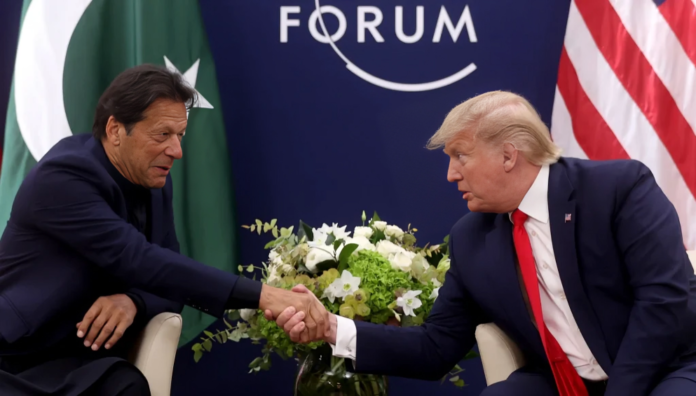In recent days, the Trump and Imran Khan viral video has been circulating on social media, claiming that former U.S. President Donald Trump promised to free Imran Khan, the former Prime Minister of Pakistan, if he wins the 2024 U.S. presidential election.
This video, dubbed the Donald Trump and Imran Khan viral video, has sparked widespread debate, particularly in Pakistan, where Imran Khan remains a highly influential figure. However, upon closer inspection and fact-checking, it has been revealed that the video is a fabrication, designed to spread misinformation.
Trump and Imran Khan Viral Video: What Does It Show?
The viral video appears to show Donald Trump speaking at a campaign rally, announcing that he would work to free Imran Khan after securing a win in the 2024 U.S. elections. According to the video, Donald Trump allegedly states that he would personally intervene to release Khan, claiming that Khan had been unjustly imprisoned by the Pakistani government.
This narrative, however, is not based on reality. Fact-checking organizations have quickly debunked the claim. The video was manipulated by merging an old speech of Donald Trump with an unrelated voice-over suggesting a promise to release Khan. In fact, no such statement has been made by Trump at any public event.
How the Video Spread and Gained Traction
The Donald Trump and Imran Khan viral video gained significant attention after being shared on various social media platforms, including Twitter, Facebook, and messaging apps like WhatsApp. Its appeal lies in its timing and its association with a high-profile political figure like Imran Khan, who remains a polarizing and highly popular leader in Pakistan. The emotional nature of the video, combined with the political climate in both the U.S. and Pakistan, made it ripe for virality.
The video was designed to play on the hopes and frustrations of Khan’s supporters, suggesting that an external ally (Donald Trump) was coming to his rescue. This form of manipulation, where facts are altered to create a narrative that aligns with political agendas, is not uncommon in today’s digital age.
Impact of Fake News and Misinformation
The Donald Trump and Imran Khan viral video is just one example of how misinformation can quickly spread in the digital age. Fake news has the power to influence public opinion, especially when it involves high-profile figures like Donald Trump or Khan. In this case, the video played into the existing political sentiment in Pakistan, where Imran Khan’s supporters often feel that the government and opposition parties have unjustly targeted him.
Misinformation like this can have serious consequences, from inciting political unrest to damaging public trust in institutions. It also highlights the challenges that fact-checkers and journalists face in combating fake news. In an era where anyone with a smartphone can create and share content, distinguishing between what is real and what is fake has become increasingly difficult for the general public.
Fact-Checking the Trump and Imran Khan Video
It’s important to approach viral content with a critical eye. The Donald Trump and Imran Khan viral video is a prime example of how easily misinformation can be spread through manipulated media.
The video in question has been debunked by multiple independent fact-checking agencies, who confirmed that the claims made in the video are entirely false. There is no evidence to suggest that Donald Trump ever made such a promise, and the video itself is an edited combination of unrelated clips designed to mislead viewers.
Fact-checkers have urged social media users to verify the authenticity of the content they consume before sharing it. Websites like Snopes and PolitiFact are valuable resources for checking the validity of viral claims. In addition, users should consider the source of the video—if the video comes from an unreliable or unknown source, it’s more likely to be fabricated.
Why Do Fake Videos Like This Go Viral?
Misinformation spreads because it plays on people’s emotions, and often aligns with pre-existing beliefs or desires. In this case, the idea of a powerful foreign leader coming to the aid of Imran Khan was an attractive narrative for Khan’s supporters, many of whom are frustrated with the Pakistani government’s stance on his legal troubles. This emotional appeal is what makes fake videos like the Trump and Imran Khan viral video so effective. They tap into public sentiment and exploit political divisions.
Furthermore, the spread of such videos is amplified by the speed and reach of social media platforms. Once a video goes viral, it’s difficult to stop its spread, and by the time it’s debunked, it has already reached a large audience.
Separating Fact from Fiction
The Donald Trump and Imran Khan viral video serves as a reminder of the dangers of misinformation in today’s interconnected world. It is crucial for social media users to approach viral content with skepticism and to verify the authenticity of the material before spreading it.
The rapid spread of fake news not only misleads the public but also contributes to a polarized and misinformed society. As consumers of news, it is our responsibility to critically assess the content we encounter and be vigilant against the manipulation of information.
In this case, fact-checkers have confirmed that there is no truth to the claim that Donald Trump promised to free Imran Khan. It’s a fabricated narrative, and the video itself is a misleading piece of content that should be dismissed.


